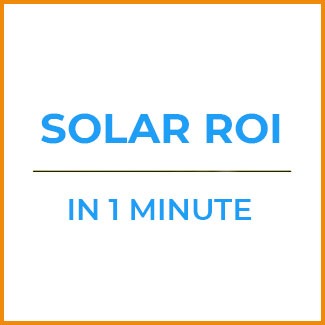Return on Investment is defined as your return over your investment.
Let’s say you bought a home for $400,000 and you rented it out and made an income of $2,500 / month after all expenses (taxes, maintenance expenses, etc).
Your first year return on your investment would be your rental income, $2,500 times 12 months, or $30,000, divided by $400,000. Or 7.5%.
Now let’s see how this math would work for a typical solar system. To calculate the ROI, we will need to understand the “Investment” and the “Return”.
RoI = Return /Investment
Let’s first look at the Investment. These days, an average solar system in the US is 5,000 Watts in size (about 20 panels, each panel being about 250 Watts). And most systems cost about $3.50 per watt to build. Actually the cost of residential solar systems range anywhere between $3 to $6 per Watt depending on various factors. But most systems costs around $3.50 per watt. So, let’s say the cost is $3.50 x 5,000 = $17,500.
Well, yes the cost is $17,500 but there is one major detail which we should not ignore. That is the “30% Investment Tax Credit”, which is basically the US Federal Government incentive that is in place until 2020 for all home owners who are going solar. This is a tax credit, which is deducted from your annual taxes, which would equal $5,250 in our above example.
So, technically this would adjust our investment amount from $17,500 down to $12,250.
Now, let’s calculate our first year return. The return is the value the solar system provides for us. In most states, in the US, solar home owners get credited the full retail value of the electricity they create and feed into the grid. The policy and mechanism which enables this is called Net Metering.
And, how do we calculate the value of this electricity? We need to know 2 things:
1) How much electricity your solar system creates.
2) How much that electricity is worth.
Your return can be calculated by multiplying (1) with (2).
1) How much electricity will your solar system create?
And this depends mostly on where you are located in the US. Despite the common misconception, there is actually little variance in solar resource and solar production from city to city. A very sunny location like San Diego gets only 15% more solar resource compared to the average. And a not-so-sunny city like Seattle only gets 15% less than the average. A solar system in an average location in the US generates about 1,450 kWh per kW in a year.
2) How much is your electricity is worth?
And the average value of electricity for consumers is 12 cents per kWh. But the value of a kWh can be as high as 50 cents or as low as 6 cents depending on where you live in the US. Most solar going consumers are paying an average of 20 cents per kWh for their electricity.
So, in our example, if we assume the value of electricity generated is 20 cents, and their system generates 1450 kWh per kW, then the 1st year return will be 5 (kW) x 1450 (kwh / kw / yr) x $0.20 = $1,450.
So our return on investment equation looks like this: $1,450 / $12,250. Which is a 11.8% first year return on our investment. Which translates as a payback period of about 8.5 years.

